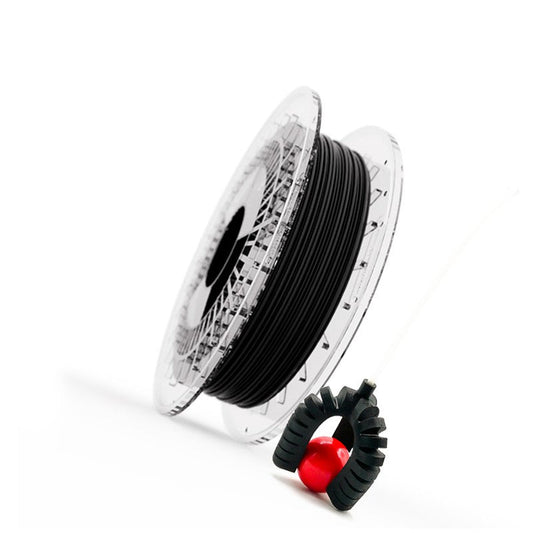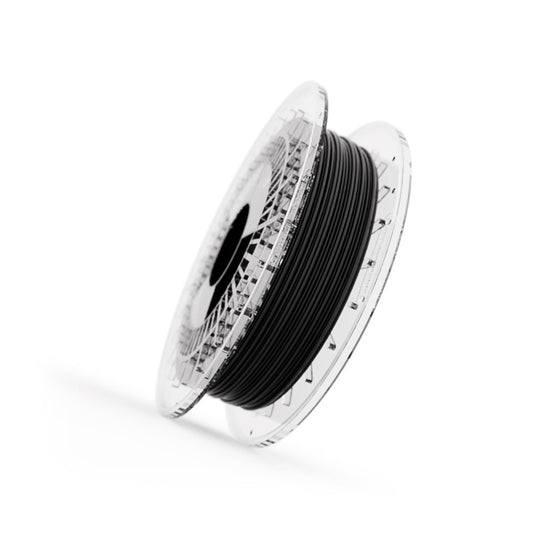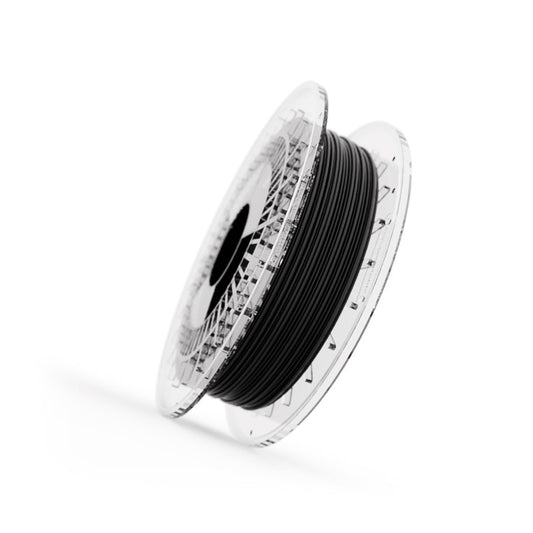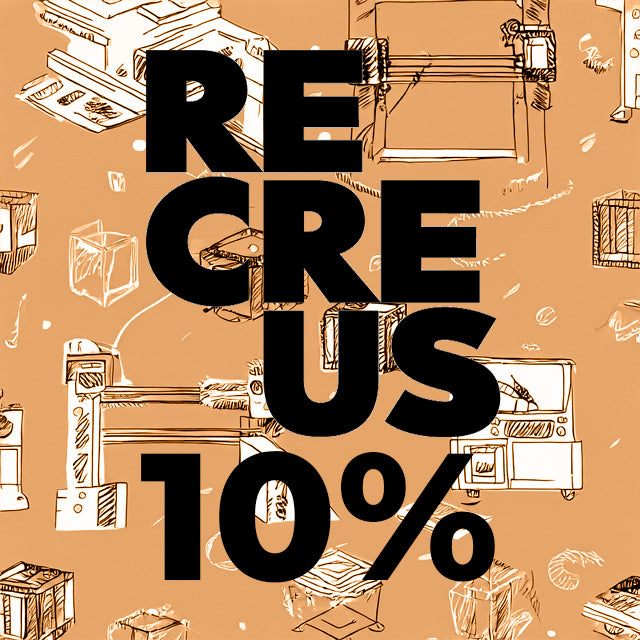PETG vs PETG - CF
PETG vs PETG-CF: Das richtige Material für Ihr Projekt auswählen
Ein umfassender Vergleich zwischen Standard-PETG und kohlenstofffaserverstärktem PETG für fortgeschrittene 3D-Druckanwendungen
PETG-Filament ist eines der vielseitigsten und beliebtesten Materialien im 3D-Druck. Seine Stärke, Haltbarkeit und einfache Druckbarkeit machen es zu einer ausgezeichneten Wahl für eine Vielzahl von Projekten. Entdecken Sie, wie unsere mit Kohlefaser verstärkte Variante diese Eigenschaften auf die nächste Stufe hebt.
In diesem Leitfaden werden wir beide Materialien detailliert untersuchen, ihre einzigartigen Eigenschaften vergleichen und Ihnen helfen zu bestimmen, welche Option am besten für Ihre spezifischen Bedürfnisse geeignet ist. Tauchen wir ein in die Welt der Hochleistungs-3D-Druckmaterialien!

PETG und PETG-CF (mit Kohlefaser) Filamente sind zwei sehr beliebte Materialien in der Welt des 3D-Drucks. Beide haben einzigartige Eigenschaften, die sie ideal für verschiedene Arten von Projekten machen.
In diesem Artikel werden wir die Unterschiede zwischen diesen beiden technischen Materialien analysieren, um Ihnen zu helfen, das für Ihr nächstes 3D-Druckprojekt am besten geeignete auszuwählen.
PETG, oder glykol-modifiziertes Polyethylenterephthalat, ist ein thermoplastisches Material, das hervorragende Zugfestigkeit, Elastizität und Hitzebeständigkeit bietet. Es ist ein leicht zu druckendes Material, was es zu einer beliebten Wahl für hochwertige 3D-Drucke macht.
PETG-CF, ist hingegen eine Variante von PETG, die Kohlefaser in ihrer Zusammensetzung enthält. Diese Kohlefaser verleiht dem Material eine größere Steifigkeit, Festigkeit und Haltbarkeit im Vergleich zu standard PETG.
Um Ihnen zu helfen, die Unterschiede zwischen diesen beiden Materialien besser zu verstehen, haben wir eine Vergleichstabelle vorbereitet, die einige Schlüsselpunkte aufzeigt, die beide Materialien unterscheiden. Lassen Sie uns ihre Unterschiede basierend auf ihrenSteifigkeitundWiderstand.


Vergleich von PETG-Filament und PETG mit Kohlefaser (PETG CF)

Die mechanischen Unterschiede und die Unterschiede in der Anwendung zwischen PETG und kohlenstofffaserverstärktem PETG (PETG CF) sind erheblich und variieren je nach den spezifischen Anforderungen der Anwendung.
PETG ist bekannt für seine Vielseitigkeit beim 3D-Druck, da es Stärke und einfaches Drucken bietet.
Im Gegensatz dazu kombiniert PETG CF die Vorteile von PETG mit der hohen mechanischen Festigkeit, die durch Kohlefaser bereitgestellt wird.
Wie jedoch im obigen Diagramm zu sehen ist, gibt es mehrere Parameter, die deutliche Unterschiede zwischen den beiden Materialien zeigen.
- STIFFNESSIm Fokus auf Steifigkeit ist PETG CF steifer als reines PETG, was ihm bessere mechanische Eigenschaften wie höhere Zug- und Druckfestigkeit verleiht. SeinZugmodulist dreimal höher als Standard-PETG und seinZugfestigkeitist doppelt. Diese zusätzliche Steifigkeit macht es ideal für Teile, die eine größere strukturelle Stabilität erfordern.
- SCHLAGFESTIGKEITTrotz der erhöhten Steifigkeit weist PETG CF eine geringere Schlagfestigkeit im Vergleich zu Standard-PETG auf. Dies liegt an der Beschaffenheit der Kohlefaser, die, obwohl sie die Steifigkeit erhöht, das Material anfälliger für Brüche unter Schlagbelastungen machen kann.
Für weitere Informationen können Sie sich auf die technischen Datenblätter (TDS) jedes Materials beziehen:
Wann sollte man PETG-Filament oder PETG-CF verwenden?

Wenn wir uns fragen, in welchen Fällen es günstiger ist, Standard-PETG-Filament oder PETG mit Kohlefaser zu verwenden, werden wir jetzt basierend auf dem, was wir im vorherigen Abschnitt gesehen haben, und aufgrund seiner mechanischen Eigenschaften detaillieren, welches Material für jede Anwendung geeigneter wäre.

Verwendungen und Anwendungen von Standard-PETG
Die Verwendung von PETG ist in Fällen, in denen es bequemer ist, ...Eine höhere Transparenz, Flexibilität und Schlagfestigkeit sind erforderlich.
Einige Beispiele für Teile, bei denen CF-freies PETG bevorzugt werden kann, sind:
- Verpackung und Flaschen:CF-freies PETG wird aufgrund seiner Transparenz, chemischen Beständigkeit und Fähigkeit, Stöße und Stürze zu widerstehen, weit verbreitet in der Herstellung von Verpackungen und Flaschen verwendet.
- Haushalts- und Dekorationsteile:CF-freies PETG eignet sich für die Herstellung von Haushaltsteilen, wie Abdeckungen für Geräte, Bilderrahmen und Objektstützen, aufgrund seiner Haltbarkeit und Bruchfestigkeit.
- Elektronische Bauteile:CF-freies PETG kann in der Herstellung von Gehäusen und Abdeckungen für elektronische Komponenten verwendet werden, aufgrund seiner Stoßfestigkeit, chemischen Beständigkeit und der Fähigkeit, hohen Temperaturen standzuhalten.

Verwendungen und Anwendungen von PETG CF
Die Verwendung von PETG mit CF ist in Fällen, in denen es bequemer ist, {{...}}.Eine höhere mechanische Festigkeit und Steifigkeit sind erforderlich.als reguläres PETG. Der hinzugefügte Kohlenstoff verbessert die Festigkeits- und Steifigkeitseigenschaften von PETG, was es für Anwendungen geeignet macht, die langlebige und widerstandsfähige Teile erfordern, ideal für:
- Strukturelle Teile:Wo die mechanischen Festigkeitsanforderungen nicht durch standardmäßiges PETG abgedeckt sind. Aufgrund seiner erhöhten Steifigkeit und Festigkeit ist PETG mit CF ideal für die Herstellung von Strukturteilen in Anwendungen wie Automobilbau, Luft- und Raumfahrt, Drohnen, Robotik, unter anderem.
- Funktionsprototypen:PETG mit CF ist eine gute Option für den Druck von funktionalen Prototypen, die Lasten oder Kräften standhalten müssen, da es eine größere Stärke und Steifigkeit als reguläres PETG bietet.
- Werkzeuge, Zubehör und Maschinenkomponenten:PETG-CF kann zur Herstellung von Werkzeugen und Zubehör verwendet werden, die anspruchsvollen Arbeitsbedingungen standhalten müssen, wie zum Beispiel Spannwerkzeuge, Montagewerkzeuge, Ausrüstungshalterungen usw. Es kann auch in der Herstellung von Maschinenkomponenten, wie Zahnrädern, Riemenscheiben oder Lagern, unter anderem, aufgrund seiner erhöhten Festigkeit und Haltbarkeit verwendet werden.









